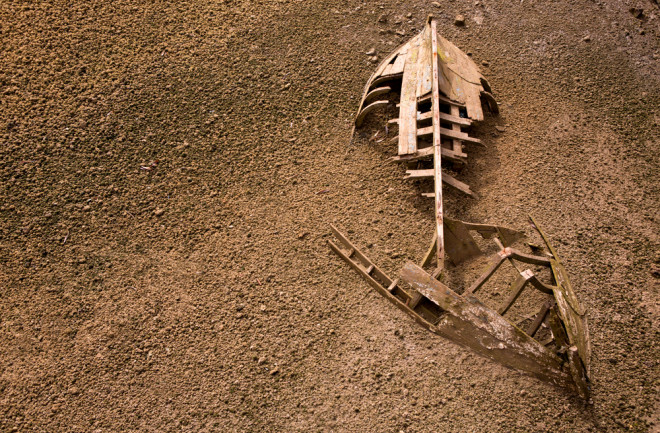When exactly humans took to the water in boats is unclear. Long considered a practice exclusive to our own species – Homo sapiens – researchers are gathering evidence that our early ancestors may have crafted and sailed boats thousands of years ago. But this theory remains contentious.
What Is the Oldest Boat Ever Found?
The world’s oldest boat dates back around 10,000 years. Discovered in 1955 in the Netherlands, the dugout canoe – known as the Pesse canoe – was crafted by axe from a Scot’s pine. Stretching back further in time, the first established boat travel is argued to be around 50,000 years ago, when Homo sapiens set forth from the mainland of Asia to colonize places such as New Guinea and Australia.
Some researchers, however, argue that sailing is not the sole domain of Homo sapiens, but our earlier relatives. Yet, in the absence of any other boats, much of the evidence for earlier seafaring remains indirect, says Bruce Hardy, chair of the Department of Anthropology at Kenyon College.
“Most of it has to do with the fact that you have human occupation on islands that were never connected by land anywhere, at any point, even when we have lower sea levels,” Hardy says. “You either have to postulate that you've got natural rafts drifting and leading to human occupation of some of these islands or you've got to have an intentional movement to the islands, which is going to have to involve some kind of watercraft.”
Did Neanderthals Sail the Mediterranean?
Some of that evidence revolves around the discovery of tools used by Neanderthals or Homo erectus on Greek islands, including Crete, which lies 40 kilometers from the mainland. As the tools date back 100,000 years, the suggestion is that a population sailed there. Another research group posit that Neanderthals could have sailed the Aegean as far back as 130,000 years ago, also based on the discovery of stone tools. They believe either Neanderthals or H. erectus may have regularly island hopped in the Mediterranean.
It’s a theory that has yet to be ruled out, but is subject to ongoing investigation and has proven controversial. Others have suggested H. erectus could have set sail around 800,000 years ago. There are also ongoing debates around the origins of Homo floresiensis, an ancient human species found on the island of Flores in Indonesia. It is believed that this diminutive species – reaching around a meter in height – may be an offshoot of H. erectus, who traveled to the island, perhaps by boat.
Read More: Who Were the Neanderthals?
Could Ancient Humans Actually Build Boats?
Adding to the evidence base that early humans had the capacity to build boats, Hardy and his team discovered the use of fiber technology at a Neanderthal site in France. Though amounting to only a single three-ply fiber strand, they argue it shows sophistication and an indication of the wider use of such practices. The strand dates back around 50,000 years.
“Twisted fibres provide the basis for clothing, rope, bags, nets, mats, boats, etc. which, once discovered, would have become an indispensable part of daily life,” they wrote in a paper published in 2020. The problem is that such materials – like wooden boats – are perishable and often don’t stand the test of time. Hardy states that researchers are often not looking for such evidence.
“That’s another piece of evidence suggesting that they really did have boats that could get them to these far-flung locations,” Hardy says. “If you’re going to build anything beyond the dugout canoe, you’ve got to be able to tie things together.”
For Hardy, boat crafting, if it was indeed occurring, is also intimately tied to the social structure of early humans. Other researchers argue that H. Erectus could effectively communicate using an established language, a theory that is divisive just like whether they were adept seafarers.
To build boats, innovations such as fiber technology and woodworking are necessary, Hardy says, but early humans would certainly have needed the ability to cooperate. “There's got to be a lot of social cooperation going on, if you're going to make a boat,” he says. In his view, researchers continue to underestimate our early ancestors’ capabilities.
Read More: Did Neanderthals Speak? Breakthrough Study Suggests Our Ancient Cousins Could Talk
The Ongoing Debate
Other possibilities exist that Neanderthals and H. erectus drifted to islands by ways of natural vegetation mats, a theory that can’t be ruled out either, says Hardy. But in his view, “there's enough evidence out there that you really have to admit that boats are involved at some point.”
Ultimately, the first intentionally built craft, and who built it, remains uncertain and open to debate.
“The level of detail and communication that comes with building boats is something that would suggest that our hominin ancestors are pretty close to us,” Hardy says. “That probably is happening much farther back than most people are willing to give credit.”
Read More: Homo Erectus: What Do We Know About Our Early Ancestors?

